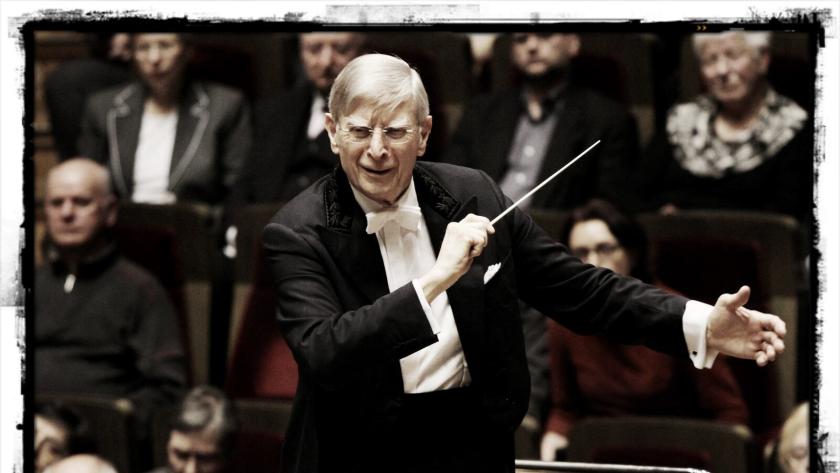Great conductors, like efficient auto engines, apply a lot of torque – they can use a little energy to achieve great surges of movement. Now aged 91, the American-born Swedish maestro Herbert Blomstedt sometimes hardly seems to raise his baton-free hands. His feet, meanwhile, remain more or less immobile. Yet, like some highly-geared sports car, last night the Philharmonia zoomed, boomed or swerved at the merest distant kiss of his fingertips.
Quietly but completely in command for the second of his Royal Festival Hall Concerts with the orchestra, Blomstedt shares with his fellow-nonagenarian Bernard Haitink (more than a year his junior) the level of artistry and authority that lets them steer through canonical works with the utmost assurance but the minimum of fuss. A few other maestros, of course, do just the reverse – desperately carving the air like some tipsy gymnast falling from the bars but to no discernible effect (insert name of favourite bête noire here…).
As with his previous pairing of Beethoven’s Pastoral and Berlioz’s Symphonie Fantastique, he opted yesterday for a brace of repertoire staples to showcase the rapport that he has forged with the alert and responsive Philharmonia. In this case, Mozart’s G minor symphony no 40 opened the way for Beethoven’s Eroica: the glorious swansong of one tradition, if you like, coupled with the epoch-making birth-pangs of another age – in which we still live. Blomstedt’s ever-tasteful classicism and purism can sound, in the abstract, a little dull as a signature style; but not when the results deliver interpretations that refresh and illuminate as much as these.
In the Mozart, elegance and delicacy reigned. Sans a stick, never consulting the score, Blomstedt hovers like some canny hawk over the musical landscape unfolding before him, then discreetly, suddenly, swooping in to pluck some tasty morsel from his chosen patch of the orchestra. Economy of effort allies with a formidable clarity of vision. The growing turmoil of the strings in the allegro built towards a climax all the more urgent for the debonair serenity that had preceded it. Blomstedt works by graded contrasts, with his changes of tempi and dynamics never violently wrenched from his players but always firmly marked. The andante swung past with an easy lilt, a saunter without slackness, as the horns led by Alberto Menéndez Escribando lent their country spices to the Viennese mix. In the grainier textures of the minuet, then in the finale, Blomstedt conjured up a string of lucid but well-connected solo touches from the woodwinds. Knife-sharp tutti rounded off a reading that, if not high in sheer excitement, oozed class and control.
Although he has never marched far down the road of “period” performance, Blomstedt’s approach has evolved as musical scholarship has moved. Last night's Philharmonia made use of natural trumpets, for example, and even though their post-interval forces almost doubled for the Eroica, the sound retained a lightness, openness and transparency that owed much to the changing musical climate. Blomstedt’s Beethoven has also picked up a little pace (47 minutes for last night's Eroica), though with nothing like the speed fetish found in other bands.
Fine, detailed craftsmanship sculpted, polished and pointed every phrase
His Eroica began with a restrained poise and pulse, letting the revolutionary nature of the music – “wrong” horn key and all – bed down on a securely classical ground. Blomstedt’s unerring lucidity means that his pianissimo passages grab the ear as winningly as this work’s famous forte coups. He found mellowness and lyricism as well as barricade-storming agitation in the first movement, aided throughout by the delicate solo touches (from oboe and cello above all) that he pinpointed and highlighted with that quiet bird-of-prey charisma. There was, indeed, an almost cartoon-like disparity between the conductor’s tranquil stance and modest gestures, and the strenuous writhing in his seat of the Philharmonia’s first-rate guest leader, Benjamin Marquise Gilmore. Blomstedt transmitted all that energy; he did not need to mimic it.
The funeral march had a relentless momentum mitigated, again, by a kind of classical aplomb. Blomstedt shunned doom-laden melodrama to allow each voice in the orchestra to sing and shine – with Tom Blomfield’s oboe, Samuel Coles’s flute and Emily Hultmark’s bassoon all on peak form. His slow-burn ascents and judicious middleweight textures meant that Blomstedt’s moments of shattering climax – in the march above all – counted for more than in the sort of Eroica that turns up the drama dial from the off and never stops to rest.
The scherzo once again gave Escribano and his fine-toned horns a chance to swagger at the back – as they did in the finale. Blomstedt lent to the dazzling set of variations that completes the Eroica an almost Mozartian blend of gravity and geniality, skittishness and solemnity. Rather than go for a sludgy, wall-of-sound effect, he laid down a luminous mosaic of musical colours in which each piece glinted hard and clear. Fine, detailed craftsmanship sculpted, polished and pointed every phrase, every passage, with admirable exactitude: splendid interventions here as well from the principal flute and oboe. This wasn’t an Eroica for fans of barnstorming, heart-on-sleeve Beethovenian passions. But it reminded you that this extraordinary music stems from a cool head as well as a soaring soul. Blomstedt and the Philharmonia held its force and its grace together in a lovely equilibrium.














Add comment